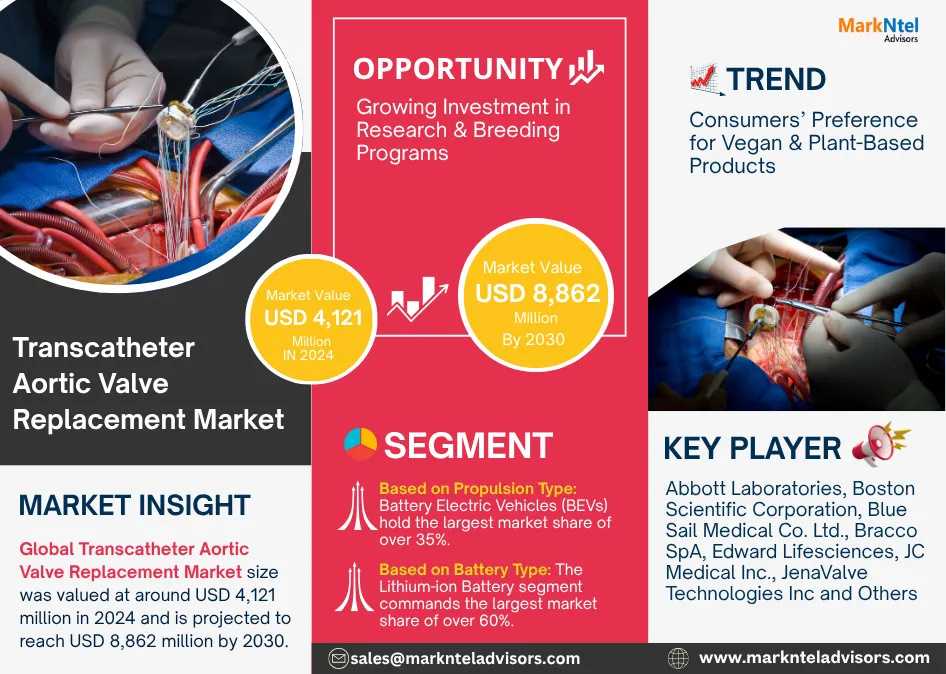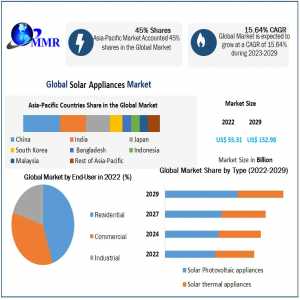
Global Transcatheter Aortic Valve Replacement Market Reaches USD 4,121 Million In 2024, Projected To Nearly Double By 2030 (CAGR 13.61%)

The Global Transcatheter Aortic Valve Replacement (TAVR) market soared to USD 4,121 million in 2024 and is forecasted to reach USD 8,862 million by 2030, growing at a robust 13.61% CAGR during 2025–2030 This growth reflects surging elderly populations, rapid advancements in valve technologies, strong government support, and the expansion of emerging markets. As minimally invasive cardiac procedures become mainstream, TAVR stands at the forefront of innovation in cardiac care.
Transcatheter Aortic Valve Replacement Market Analysis
- Rising Aging Populations & Aortic Valve Disease
– Global increase in individuals aged 60+ is pushing demand for less invasive cardiac surgeries.
– Aortic stenosis prevalence is driving annual growth in TAVR procedures. - Technological Enhancements
– Balloon-expandable and self-expanding valves now more reliable, compact, and easier to implant.
– Use of advanced materials like nitinol and cobalt-chromium improves long-term durability. - Government & Regulatory Momentum
– Public healthcare schemes (e.g., Medicare in the US and similar programs in Europe) now reimburse TAVR procedures.
– Fast-tracked approval pathways are accelerating device launches. - Healthcare Infrastructure in Asia-Pacific
– Investments in cardiac centers in China, India, and Japan are boosting access to TAVR.
– Skilled workforce and growing medical tourism are supporting market growth. - Industry Consolidations & Collaborations
– Key players are partnering with local medical device firms to co-develop next-gen valves.
– M&A activity strengthens distribution networks and accelerates innovation
Key Takeaways from Market Research Report
- 🟢 Demographic expansion: Accelerating prevalence of aortic valve disorders in elderly populations.
- 🟢 Innovation surge: Technological advancements in TAVR systems and delivery mechanisms.
- 🟢 Regulatory tailwinds: Favorable reimbursement frameworks and expedited approvals.
- 🟢 Infrastructure drive: Development of cardiac care facilities in Asia-Pacific.
- 🟢 Strategic alliances: Collaborations fueling R&D and geographic expansion.
Transcatheter Aortic Valve Replacement Market Leading Players Driving Innovation & Growth
Market participants shaping the landscape include
- Abbott Laboratories
- Boston Scientific Corporation
- Blue Sail Medical Co. Ltd.
- Bracco SpA
- Edward Lifesciences
- JC Medical Inc.
- JenaValve Techologies Inc.
- Medtronic Plc
- Meril Lifesciences
- Venus Medtech
- Jude Medical, Inc.
- Coroneo Inc.
- Thubrikar Aortic Valve Inc.
These companies consistently invest in refining delivery systems, hybrid valve mechanisms, and remote monitoring capabilities, setting benchmarks in clinical excellence.
Access the detailed PDF Sample report – https://www.marknteladvisors.com/query/request-sample/transcatheter-aortic-valve-replacement-market.html
Transcatheter Aortic Valve Replacement Market Segmentation Analysis
By Procedure
- Transfemoral
- Transapical
- Transaortic
By Mechanism
- Balloon-expandable
- Self-expandable
By End User
- Hospitals
- Ambulatory Surgical Centers
- Others
By Material
- Nitinol-
- Cobalt Chromium
- Stainless Steel
- Others
Spotlight on a Growth Driver
A key momentum driver is the shift from open-heart surgery to minimally invasive techniques. TAVR procedures, often performed via the femoral artery, now offer comparable—or at times superior—clinical outcomes, especially for older, high-risk patients. Reduced hospital stays, faster patient recovery, and lower complications are increasingly favored by healthcare providers and patients alike. This patient-centric shift is a unique narrative in the TAVR market: delivering both clinical and economic value, reshaping how cardiac care is delivered worldwide.
Leading Segment Explored
The transfemoral procedure segment leads the market, supported by less complex access routes and shorter recovery periods. In 2024, it accounted for the highest share of all TAVR procedures. Its popularity stems from improvements in catheter-based delivery—allowing access through peripheral arteries rather than open chest procedures. As devices shrink and skill levels increase, transfemoral TAVR is expected to deepen its dominance, especially in outpatient surgical centers and high-volume hospitals focused on efficiency and patient outcomes.
Regional Market Insights
North America, led by the U.S., remains the largest regional market. Here, comprehensive reimbursement policies, strong hospital networks, and high valve acceptance rates continue to fuel adoption . In Asia-Pacific, China, Japan, India, and Australia are emerging fast; state-of-the-art cardiac facilities in Beijing and Mumbai are making TAVR more accessible. India is on the verge of becoming a TAVR hub due to operator expertise, cost advantages, and growing elderly patient pools—offering a crucial growth frontier.
Future Outlook
With the growing trends the industry is projected to grow and expand during the forecasting years i.e., 2025–30 as the above-stated factors are changing the market landscape and opening doors to the market players. Market players can enhance their market size & revenue by meeting the changing market dynamics and evolving consumer expectations. Additionally, market players with the help of SWOT analysis can adjust their existing settings regarding the evolving market trends, which would ultimately augment the size & volume of the entire industry at the global level.
Author Bio
Article Comments
No Comments!
At present there are zero comments on this article.
Why not be the first to make a comment?
Similar Articles
Search Pages
User Upgrade
account to full use of editor,
Including hyperlinks
Article Categories
There are zero sub-categories in this parent category.
There are zero sub-categories in this parent category.

















